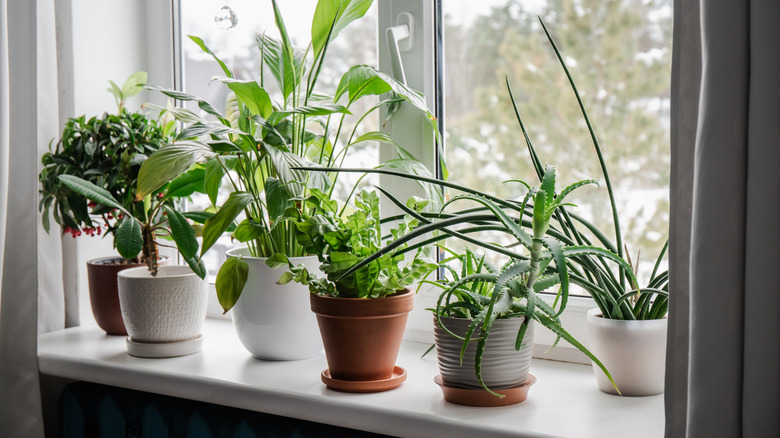The Affordable Product You Can Use To Keep High-Temp Loving Houseplants Happy
Preparing outdoor plants for winter is at the top of the list for most gardeners, but don't overlook the importance of winter care for your houseplants. Although they are indoors, winter is a vulnerable time for houseplants, with drooping foliage and root rot being common problems. The affordable product you can use to keep your houseplants happy in winter is a seedling heat mat.
Your indoor plants need winter care too. The number one thing to do is to avoid overwatering. Most plants require less water in the winter, so it is important to make sure they aren't getting too much. Signs your plants may be getting overwatered include wet soil, wilting, and leaves that are yellowing or dropping off.
There are many ways to tweak your houseplant care routine for winter. Suggestions often include ways to increase humidity, protect plants from drafts, and keep the roots warmer. Using a heat mat under your plants will warm the roots and provide a consistent source of warmth through the coldest months of the winter. To avoid overwatering, only water the plant when the top few inches of soil are dry and make sure the excess water can drain out of the pot.
How to use heat mats for houseplants
You don't have to crank up the heat in the house to keep your plants comfortable in the coldest months of the year. Seedling heat mats are designed for germinating seedlings and keeping them warm, and they can do the same for your houseplants. Placing a heat mat under your plants can help keep the soil and roots warm. These mats use much less electricity than your heating system.
A heat mat works in a similar way as a heating pad. The mats have internal heating wires that are encased in layers of plastic that are designed to raise the temperature of your soil between 5 to 10 degrees Fahrenheit to help propagate seeds or keep the soil and roots of houseplants warmer. The outer plastic covering of the heat mat is waterproof, so it is safe to use when watering your plants.
You unroll the mat and plug it into the wall before placing your plants on top of it. Use a drip tray under the plant to keep the soil from getting too warm. As long as the room doesn't get too cold at night, you can switch off the mat if you are worried that your plants will get hot.
Precautions and things to watch out for
When using a heat mat for your plants, there are a few precautions to take to get the best results. One potential issue is overheating. You want the soil and roots to get warm but not overheated, so look for mats with temperature control. This doesn't mean spending more, as the cheapest seedling heat mat from Home Depot offers this feature. A thermometer can also be used to monitor soil temperature to prevent overheating.
There are some safety precautions to consider when using a seedling heat mat for your houseplants. Heat mats should not be used on carpets, rugs, or any flammable materials. Other things to avoid include overlapping heat mats and folding or creasing the mat, as this could damage it.
Keep in mind that warmer soil and roots may absorb more water. Just like you should avoid overwatering in winter, it is important to avoid underwatering. The soil may dry out faster when using a heat mat, so check your plants regularly and water them when the top layer of soil is dry.


